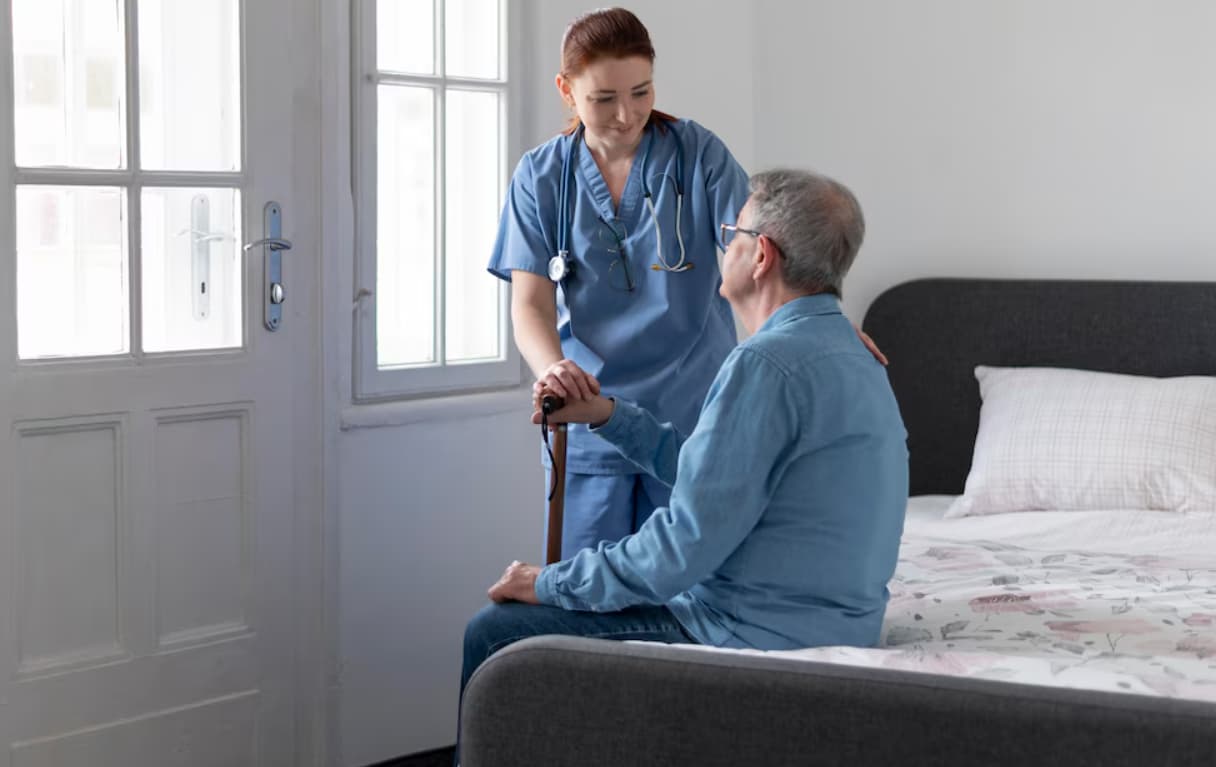When a loved one faces a life-limiting illness, families often search for ways to provide comfort and dignity during their final journey.
Hospice care emerges as a valuable resource, but many questions arise about what it truly entails.
Perhaps no question is more common than “Does hospice provide 24-hour care at home?”
This uncertainty reflects the natural concern families have about ensuring their loved ones receive adequate support around the clock.
The transition to end-of-life care represents one of life’s most challenging passages. Families want assurance that their loved one will not face pain, discomfort, or loneliness during this vulnerable time.
The prospect of managing serious symptoms, especially during overnight hours, can feel overwhelming to even the most dedicated family caregivers. This concern often leads to the hope that hospice services include continuous bedside care.
Understanding the true scope of hospice services helps families develop realistic expectations and create comprehensive care plans.
Hospice offers an interdisciplinary approach to comfort care, bringing together medical expertise, emotional support, and practical assistance.
While it provides invaluable benefits, standard hospice services do have limitations regarding continuous care coverage that families should understand before making decisions.
Does Hospice Cover 24-Hour Care at Home?

This guide aims to clarify exactly what hospice care includes, with special focus on the question of 24-hour coverage.
We’ll explore the philosophy behind hospice, examine its various levels of service, discuss when around-the-clock care might be available, and offer practical solutions for families needing more extensive support than standard hospice provides.
With this information, families can make informed choices that honor their loved one’s wishes while also addressing practical caregiving realities.
Does Hospice Cover 24-Hour Care at Home?
Not routinely. Only during documented symptom crises.
The Hospice Philosophy: Comfort, Dignity, and Support
Hospice represents a fundamental shift in healthcare priorities. Rather than focusing on curing illness, hospice embraces a philosophy centered on quality of life and comfort. This approach recognizes that when curative treatments are no longer effective or desired, patients deserve care that minimizes suffering and maximizes meaningful living in whatever time remains.
Core Principles of Hospice Care
- Comfort-focused treatment: Managing pain and symptoms effectively becomes the primary goal
- Holistic approach: Addressing physical, emotional, and spiritual needs
- Patient-centered decisions: Respecting individual preferences and values
- Family inclusion: Supporting loved ones as essential members of the care team
- Life affirmation: Neither hastening nor postponing death, but making remaining time meaningful
Unlike traditional medical care, which often fragments treatment across specialists and settings, hospice brings together diverse professionals who coordinate their efforts. This team typically includes:
- Physicians who direct the overall care plan
- Nurses who monitor symptoms and provide skilled care
- Home health aides who assist with personal care needs
- Social workers who help with emotional and practical concerns
- Chaplains who offer spiritual support (if desired)
- Volunteers who provide companionship and assistance
- Bereavement counselors who support families through grief
This team approach ensures that all aspects of a person’s well-being are addressed, creating a support system that extends beyond just medical needs. The goal is to help individuals live as fully and comfortably as possible for whatever time remains, surrounded by those they love in an environment where they feel most at peace.
Hospice Eligibility and Settings: Where Care Happens
Hospice services are available to individuals with a prognosis of six months or less if their disease follows its expected course. This doesn’t mean services end after six months—patients can continue receiving hospice care as long as they remain eligible, with recertification required periodically.
Common Qualifying Conditions
- Advanced cancer
- End-stage heart, lung, or kidney disease
- Advanced dementia or Alzheimer’s disease
- ALS (Lou Gehrig’s disease) and other neurological conditions
- End-stage liver disease
- AIDS in its final stages
- General frailty and decline (“failure to thrive”)
Where Hospice Care Takes Place
One of hospice’s greatest strengths is its flexibility regarding location. Care can be provided in various settings:
- Private homes: Most hospice care (approximately 70%) occurs in patients’ residences
- Nursing facilities: Hospice teams can serve residents in nursing homes or assisted living facilities
- Dedicated hospice facilities: Some organizations maintain inpatient units for short-term or continuous care
- Hospitals: Many hospitals have specialized hospice units or partnerships
This flexibility allows patients to receive care in the environment where they feel most comfortable. Many prefer to remain at home, surrounded by familiar people and possessions. Others may need or prefer the additional support available in residential facilities. Regardless of setting, the hospice team coordinates care to maintain consistency and quality.
The Four Levels of Hospice Care: Understanding the Spectrum
Medicare and most private insurers recognize four distinct levels of hospice care. These levels allow the intensity of services to adjust based on the patient’s changing needs.
1. Routine Home Care
This is the most common level of hospice service, accounting for approximately 95% of all hospice care days. It includes:
- Regular scheduled visits from various team members
- Frequency determined by the care plan, typically several times weekly
- 24/7 telephone access to a registered nurse for guidance
- Medications, equipment, and supplies related to the terminal diagnosis
Routine care works well when symptoms are relatively stable and can be managed with intermittent professional visits combined with care from family members or facility staff between visits.
2. Continuous Home Care
This intensive level is designed for brief periods of crisis when a patient experiences acute symptom flare-ups:
- 8-24 hours of continuous nursing care in the home setting
- Primarily, nursing services focused on managing severe symptoms
- Short-term duration until symptoms stabilize
- Purpose: keeping the patient at home through a crisis that would otherwise require hospitalization
Common situations warranting continuous care include severe pain episodes, breathing difficulties, uncontrolled nausea, or anxiety during active dying.
3. General Inpatient Care
When symptoms cannot be adequately managed in the home, patients may temporarily receive care in an inpatient facility:
- 24-hour nursing care in a hospital, hospice inpatient unit, or nursing facility
- Intensive symptom management under direct medical supervision
- Short-term placement with return to routine care once symptoms are controlled
This level serves patients experiencing complex symptoms requiring around-the-clock professional intervention beyond what can be provided at home.
4. Respite Care
This level is designed primarily to provide temporary relief for family caregivers:
- Short-term inpatient care (usually up to five days)
- Continued hospice services in an inpatient setting
- Purpose: preventing caregiver burnout and allowing family members to rest
Respite care acknowledges that family caregivers need occasional breaks to maintain their health and well-being.
| Level of Care | Primary Purpose | Duration | Setting | Professional Presence |
|---|---|---|---|---|
| Routine Home Care | Regular symptom management | Ongoing | Home/Facility | Intermittent visits |
| Continuous Home Care | Crisis management | Brief (hours to days) | Home | 8-24 hours of nursing |
| General Inpatient Care | Acute symptom control | Brief (days) | Facility | 24-hour staffing |
| Respite Care | Caregiver relief | Up to 5 days | Facility | 24-hour staffing |
Patients may move between these levels as their condition and needs change. The hospice team continually evaluates what level of care is most appropriate, adjusting services accordingly.
The Reality of 24-Hour Coverage: What Hospice Provides
Now we come to the central question many families ask: Does hospice provide 24-hour care at home? The straightforward answer is no, not as a standard ongoing service. However, there are important nuances to understand.
Standard Home Hospice Coverage
Under routine home hospice care:
- Hospice team members make scheduled visits based on the care plan
- Visits might range from several times per week to daily, depending on needs
- A typical nurse visit lasts 1-2 hours
- Home health aide visits (for personal care) typically occur 2-3 times weekly for 1-2 hours
- Other team members visit on varying schedules, often weekly
Between these scheduled visits, family members or other caregivers are expected to provide hands-on care. This is a crucial point that sometimes creates misunderstandings when families first consider hospice.
24/7 On-Call Support
While physical presence is intermittent, hospice does provide:
- 24-hour telephone access to a registered nurse
- Guidance for managing symptoms or concerns at any hour
- Ability to dispatch a nurse for urgent situations
- Help determining when emergency services might be needed
This around-the-clock availability ensures that professional guidance is always accessible, even when team members aren’t physically present in the home.
When More Intensive Care Is Available
There are specific circumstances when more continuous care might be provided:
- During crisis periods under the Continuous Home Care level
- When severe, uncontrolled symptoms develop
- For limited durations (typically hours to a few days)
- Until the crisis resolves or the patient stabilizes
It’s important to understand that continuous care is designed to be temporary, addressing specific medical crises rather than providing ongoing caregiving presence. Medicare and insurance guidelines strictly define when this level of care is appropriate.
The Caregiver Gap
This reality creates what many families experience as a “caregiver gap”—the difference between the intermittent professional support hospice provides and the continuous care many patients require. Filling this gap typically requires some combination of:
- Family members taking shifts
- Friends and community volunteers
- Privately hired caregivers (not covered by hospice benefits)
- Moving to a setting with 24-hour staffing
Understanding this limitation upfront allows families to make realistic plans for caregiving needs beyond what hospice directly provides.
Solutions for Families Needing 24-Hour Support
When a loved one requires more continuous presence than standard hospice provides, several options can help bridge the gap.
Family Caregiving Networks
- Creating a schedule of family members taking shifts
- Using online care calendars to coordinate multiple helpers
- Identifying specific tasks each person can manage
- Recognizing each family member’s limitations and strengths
Private Hire Options
- Professional caregivers (home health aides, CNAs, or companions)
- Typically cost $20-30+ per hour depending on location and level of care
- Can be scheduled for specific shifts or live-in arrangements
- Not covered by Medicare’s hospice benefit or most insurance
- May be covered by long-term care insurance or VA benefits for eligible veterans
Community Resources
- Volunteer organizations that provide respite sitting services
- Faith communities that organize care teams
- Disease-specific organizations (like the ALS Association or the Cancer Society) that may offer limited volunteer support
- Local aging services departments that might have caregiver support programs
Facility-Based Options
- Continuing hospice services after moving to a nursing facility
- Adult family homes or small group homes
- Assisted living communities with enhanced care options
- Dedicated hospice houses (limited availability in some communities)
Financial Assistance Possibilities
- Long-term care insurance (if a policy was purchased previously)
- Veterans’ benefits for eligible individuals
- Medicaid programs for those who qualify financially
- Life insurance policies with accelerated death benefits or life settlements
- Community-based grant programs (limited availability)
Making the Decision: Is Home Hospice Right for Your Situation?
Determining whether home hospice is viable for your loved one requires an honest assessment of several factors.
Considerations for Successful Home Hospice
- Caregiver availability: Is there a network of family or hired help sufficient to cover needs between hospice visits?
- Home environment: Is the space conducive to caregiving? Can a hospital bed and other equipment be accommodated?
- Patient stability: How predictable are the patient’s symptoms? How frequently do crises occur?
- Financial resources: If additional caregiving is needed, are funds available to hire help?
- Caregiver health: Are family members physically and emotionally able to provide the needed care?
- Patient preference: Where does the patient truly want to receive care?
Signs That Home May Not Be the Best Option
- Caregiver burnout despite available supports
- Safety concerns that cannot be adequately addressed
- Rapidly changing or complex medical needs requiring frequent intervention
- Inadequate physical setup in the home
- Limited caregiver availability due to work, distance, or other obligations
Having Difficult Conversations
Many families struggle with guilt when they realize they cannot provide 24-hour care at home without substantial additional help. Remember:
- Quality of care matters more than location
- Exhausted caregivers cannot provide optimal support
- Sometimes the most loving choice is recognizing limitations
- Hospice care continues regardless of setting
The hospice team, particularly social workers and nurses, can help facilitate these difficult conversations and support families in making decisions that balance preferences with practical realities.
FAQs About Hospice and 24-Hour Care
- Does Medicare pay for 24-hour hospice care at home?
Medicare’s hospice benefit does not cover 24-hour continuous care as a standard service. It covers intermittent visits, medications related to the terminal diagnosis, medical equipment, and supplies. Continuous care is only covered during documented crisis periods when intensive nursing care is needed to manage acute symptoms.
- How quickly can a hospice nurse come if we have a problem at night?
Response times vary by hospice and location. In urban areas, a nurse might arrive within 30-60 minutes. In rural areas, it could take longer. The on-call nurse will help assess over the phone whether an in-person visit is needed immediately or if guidance can be provided until morning.
- What if my loved one falls and I can’t lift them?
This is a common concern. The hospice team can:
- Teach safe transfer techniques
- Recommend appropriate equipment
- Suggest home modifications to reduce fall risk
- Guide on when to call emergency services (911) for assistance
- Will hospice provide more visits if my loved one’s condition worsens?
Yes, visit frequency can be adjusted based on changing needs. As the patient’s condition declines, nurses typically visit more frequently. However, even with increased visits, hospice does not transition to providing continuous care unless specific crisis criteria are met.
- What happens if we can no longer manage care at home?
The hospice team can help facilitate a transition to an appropriate care setting, such as:
- A nursing facility
- An inpatient hospice unit
- A hospice house (where available), Hospice services continue uninterrupted regardless of location changes.
Also Check:
- Health Needs of Youth in Grand Marais Minnesota
- Jen Blanco and Nuvita Health
- I’m A Friend of Mrs Lussick
- Tom Platz Net Worth
Conclusion: Finding the Right Care Approach
Understanding the realities of hospice care helps families develop appropriate expectations and comprehensive care plans.
While hospice does not typically provide 24-hour hands-on care at home, it offers something equally valuable: expert medical support, comfort-focused care, and emotional guidance throughout the end-of-life journey.
The question “Does hospice cover 24-hour care at home?” has a nuanced answer. Standard hospice services include intermittent visits and 24/7 telephone support, with continuous in-person care available only during defined crisis periods.
For families needing more constant presence, combining hospice services with additional caregiving resources—whether family, hired help, or facility-based care—creates a more complete support system.
When considering hospice, families should:
- Have realistic conversations about caregiving capabilities
- Explore all available community resources
- Consider the financial implications of various care options
- Focus on the patient’s wishes, balanced with practical realities
- Remember that quality care can happen in various settings
Hospice care isn’t defined by location or hours of service. Its essence lies in the compassionate approach that prioritizes comfort, dignity, and quality of life.
With proper understanding and planning, families can work with hospice teams to create care arrangements that honor their loved one’s journey while also being sustainable for everyone involved.
The path through end-of-life care isn’t easy, but with the right expectations and support, it can become a meaningful time of connection, comfort, and even moments of peace.
Hospice helps make this possible by providing expert guidance when it matters most, ensuring that patients and families never have to navigate this challenging path alone.



